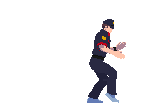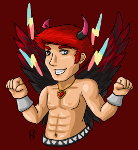 Add Review
Add Review Subscribe
Subscribe Nominate
Nominate Submit Media
Submit Media RSS
RSS
- Summary
- Blog
- Images
- Reviews
- Media
- Survival Tips
- Characters
- Videos
- You might also like...
- Downloads
- Play Lists
Nico is only a few major changes away from greatness.
 Decky
Decky- 06/12/2011 06:37 PM
- 10993 views

This review contains spoilers for both this game and various Square Enix games.
Let's face the facts: our community has been treated to many entertaining games made with the outdated RPG Maker 2003 engine. Hero’s Realm, Alter A.I.L.A. Genesis, Leo & Leah, and The Tiamat Sacrament are just a few examples of this interesting trend. Despite its numerous flaws and the presence of vastly superior programs, RPG Maker 2003 is still a go-to engine for game designers interested in a more classic approach to RPGs. Nico looks to continue this trend with Forever’s End.
In development since 2008, Forever’s End is Nico’s first major project. First impressions would suggest otherwise; most aspects of the game are competently planned and designed, and Nico’s gameplay mechanics are enjoyable, innovative, and well executed. However, a closer examination will reveal numerous underlying flaws that are common among newer developers. These flaws, while substantial, do not necessarily break the back of the first episode of what could become the next RPG Maker 2003 classic.
This review covers the May 2011 version of the game, which features approximately 10-12 hours of gameplay. Based on the escalation of events, levels, and characterization, I would assume that Nico is about thirty to forty percent complete. Factoring in optional content and leveling, it would not surprise me if this game reaches the “fabled” 35-to-40 hour benchmark set by the PSX Final Fantasy installments.
This is the first part of a somewhat outdated LT of the game. Nevertheless, some of the points I address still stand.

In the opening hours, the story of Forever’s End is an amalgamation of various RPGs from Squaresoft’s “Golden Age”. The main protagonist, Epoch, shares many similarities to Cecil of Final Fantasy IV fame: both are young military leaders questioning their loyalty to the crown after their respective kings demand the acquisition of several powerful crystals. Both characters have to commit heinous crimes to obtain the first crystals, and both eventually defect and become fugitives.
This is only the most obvious connection; there are also many similarities between Forever’s End and Final Fantasy IX. Both games feature shadowy “advisers” who are the real prime movers behind the malicious events, as well as comical mercenaries, young nobles with hidden powers, and heads of state on the high-speed lane toward insanity. Final Fantasy VIII-style dream sequences are also present at predictable intervals. The game also pays homage to Chrono Trigger and Xenogears through an array of time travel and pseudo-religious and technological themes (as well as what I assume are reincarnating main characters, though this is yet to be confirmed). Players will also find stereotypical goblins, drunken swordsmen, naive noblewomen, rogue mercenaries with demonic powers, headstrong female guardians, and every other archetype known to Square fans.
I was not turned off by these reused themes and cliches, mainly because they tend to work as story devices. Nico also does a good job of putting an original spin on all of them—names and events are original, even if the themes are not. Characters sometimes move beyond their typical archetypes; for instance, the drunk swordsman is not exactly the fatherly guardian that Auron was, and the goofy and annoying rich girl is actually not the same character as the girl with the unlockable powers. There is also a legitimate attempt at world building, conveyed in the form of flashbacks, dream sequences, and a story-driven time travel dungeon. Plus, the cliches become much more isolated in the latter half of the demo: the main story begins to gain traction at this point, and the subordinate antagonists take center stage in lieu of the generic Evil King/Shady Adviser duo.
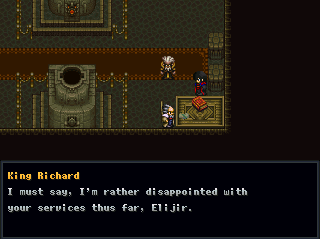
Insane kings, obligatory manipulative advisors,
and goofy mercenaries, oh my!
and goofy mercenaries, oh my!
It almost seems as if the first few hours serve as a tribute to Nico’s JRPG influences, in a manner similar to Kentona's approach to Hero’s Realm. This is not a bad thing, as long as it is billed as such. If Nico makes it known that the story starts off as a sort of tribute to Squaresoft’s Golden Age, then I think more people will be receptive to it and will be much more patient with the story. It could be a billing as simple as "this is a game that starts off paying tribute to classic Square-Enix storytelling but evolves into something greater."
Cliches aside, the story itself is a mixed bag. Nico puts a lot of effort into the presentation of the story, and the cutscenes are very well done as a result. Booble’s artwork and the various sprite poses help bring the story alive and give context to some scenes that would otherwise be fairly confusing. However, the dialogue is often redundant and slow-paced, leading to more than one occasion of button mashing on my part. There are enough mysteries in play to keep me interested, but I did find the “cliffhanger” at the end of Episode One to be underwhelming. The game needs additional early-game plot twists to bait players, especially those who think this game is another Shrine of Triteness. I highly suggest that Nico use the cliches and assumptions as pure misdirection, mainly to spice up the plot and give complacent players a bit of a surprise and reason to keep playing.
Most of the characters have an interesting and/or unique trait. One of the king’s hired guns can control the minds of powerful beings—as long as they are weakened in combat. This would be a great battle command should this character become playable (hint hint, Nico!). Another character reminds me a lot of Fei Fong Wong from Xenogears: he has a nasty split personality that is held in check only by some sort of implant. This character is exceptionally well written and is probably my favorite so far.
Unfortunately, I am not attached to most of the characters. This is not necessarily a major fault with Nico’s writing, as I prefer plot and setting-driven storylines to character-driven tales. There is clear effort here, and I think a focus on succinctness will improve both the story and characterization. If the cutscenes are more concise and direct, players will be more likely to absorb the key information and keep track of all the variables in play. They will have a higher chance of becoming engaged with and enjoying the story, thus giving them a solid reason to continue playing.
Nico also needs to do a much better job with characterization by eliminating the obvious and focusing on implying things. He has a tendency to spell out exactly what a character is thinking—in excruciating detail. I love reading what the character is thinking, but only to a point; it does not hurt the story if a designer leaves some of the rationalization up to the player. Shortening the monologues and self-rationalization would go a long way toward tightening some of these cutscenes.
There is another point I would like to discuss: we as players are still in the dark about much of the goings-on. I have yet to acquire a feel for what the characters are coming together to do; they still seem to be going through those "Disk One" stage directions. The tag-along syndrome rears its ugly head throughout much of the middle hours—some characters have less of a motive to join the “cause” than Jar Jar Binks from Star Wars! The real plot has yet to be revealed, and this could be contributing to my lack of engagement. The only other thing keeping me playing from a story perspective is the intriguing back story (involving demons called the “Lost”) and the nebulous concept of “Forever’s End” itself. It doesn't help that the introduction is vauge and overlong, as many have pointed out.
In short, the story—while above average for an RPG Maker game—is a mixed bag. The characters have some interesting traits and the story pays homage to many classic SNES and PS1 titles, but the cutscenes are often long-winded and the main conflict has yet to truly come into focus. The elements are in place for a wonderful tale: Nico just needs to spice up the story, focus on concise storytelling, and accelerate the rising action.
Story metrics:
Setting: 3.5/5 (30%)
Characters: 3/5 (35%)
Plot: 2.5/5 (35%)
Overall: 3/5: "Above Average"

The game itself is very enjoyable—that is, once the player passes through the tedium and simplicity of the first few dungeons and battles. There are plenty of nooks and crannies in each dungeon, as well as treasures and rare monsters to fill them. Gold is plentiful, and believe me: there are plenty of things to spend the gold on. As a matter of fact, there may be too many items; the inventory screen becomes far too unwieldy once the main gameplay mechanics are introduced. I'll talk more about this later.
There is a very nice structure to each dungeon that revolves around fixed monster encounters. If the player eliminates all monster encounters in the dungeon, the entire party will receive a permanent stat increase. Furthermore, players can “capture” one of every monster type in the area during battle to receive a special item. Captured monsters can even be used as items in the form of enemy skills! These elements break the usual monotony of hacking, slashing, and firaga-ing our way through long hallways.
Additionally, players can “scan” enemies during battle using special items called "scan crystals". This is always a welcome feature in RPGs, and Nico demonstrates mastery of the mechanic here. Scanning a monster reveals virtually everything and anything about it: stats, weaknesses, resistances, capture prerequisites (in the form of minimum level and type of bait needed), and a basic description. All of this information is retained in a Bestiary that is divided by dungeon. Scanning a new enemy also yields Scout Points, which accumulate throughout the game. When the player’s “Scout Level” increases, he or she gains access to a new assortment of rare monsters in each area. In short, this game is a completionist’s dream come true.
The battles themselves are fairly fast-paced, though Nico made the mistake of actually using the agility stat. Why is this a mistake? RPG Maker 2k3’s Active Time Battle speed is far too slow—I would much rather see a fixed (or near-fixed) agility level. But this is a fairly minor issue, and I did not run into many instances where I was forced to wait impatiently for the ATB gauges to fill.
Enemies have an assortment of elemental and physical weaknesses, which make scanning them all the more useful. After the first couple of areas, enemies also become quite hard hitting; there are plenty of healing spells and items to compensate. Nico was also clever enough to place enemy weaknesses in the status effect bar (once the enemy is scanned)—players are therefore not forced to memorize elements or physical vulnerabilities.

Using the status effect display to list weaknesses was
a nice touch, though it can limit the actual status effect
system because 2k3 can only display a few at any given time.
a nice touch, though it can limit the actual status effect
system because 2k3 can only display a few at any given time.
Outside of the weakness system, there is not much in the way of high-end strategy—at least not yet. Some of the bosses feature gimmicks that require use of a character’s unique abilities, and one boss even switches up its element every few turns. Sadly, though, most battles often turn into the typical spamfest seen in most RPGs, commercial and amateur alike.
One way to improve the actual strategy and flow of battles is to incorporate more status effects—or, at least, make their use more common or necessary. As of the end of this episode, I have yet to use a single status effect on an enemy, and have only seen my characters disabled on a handful of occasions. There was even one dungeon in which NPCs warned that the monsters were fond of silencing party members, yet I was only silenced during the boss fight. Some of those very same monsters did not even have any major weaknesses to magic—a missed opportunity for some clever strategy. I would also like to see monster parties play off each other a bit more: healers, buffers, and physical/magical attackers should work together in much the same way as our party. Perhaps one monster can reduce the party’s resistance to fire; Nico could then turn on a switch that makes another monster spam fire. That monster could also dabble in status effects like poison or burn before it begins spamming fire; should the player defeat the de-buffer first or the guy who can ruin the party with statuses before spamming magic? It's an interesting scenario. Giving the player more decisions on which monsters to kill or capture first could go a long way toward making battle strategy just as fresh as the rest of the gameplay.
The characters are far more interesting from a gameplay perspective than from a story perspective. As I just mentioned, most characters have some sort of gimmick or special secondary command. For instance, the drunk swordsman can consume various types of alcohol from the player’s inventory to change his skill sets during battle (e.g. tequila turns him into a black mage, while vodka turns him into a healer). The goblin character has his own bag of “item” skills instead of the usual party inventory. To add items to this bag, he must physically create a prototype in the main inventory screen (often requiring items that he can steal from enemy parties). The stereotypical elderly mage can use tarot cards from the inventory that have either a positive or negative effect—depending on what side they land on.
All characters have limit breaks—powerful abilities that deal high damage or offer other substantial advantages to the party. These abilities can be used once the gauges next to each character’s portrait are full. These gauges increase whenever characters perform an action, though some powerful skills and enemy attacks can decrease the gauge as well. To speed up the process, players can use the “spirit” command to defend and raise the gauge at a faster rate than a normal action. Limit breaks were useful during boss fights in which I had not learned the magic associated with the enemy’s elemental weakness. I was basically able to bide my time using the Spirit command and unleash the powerful moves. One thing I really enjoyed about this system was that the limit breaks tended to match the character’s overall role and personality. The real downside to this system is that the limit break command replaces the typical attack option—this forces players to rely on magic or secondary commands to defeat weaker enemies when the gauge is full.
Most characters can learn generic magic spells by equipping special books. Each book offers one magic spell, as well as a variety of stat changes (much like a normal piece of equipment). Nico succeeded at making these stat changes fit the type of spell learned—a wind spellbook, for instance, boosts the agility stat, while a fire spellbook boosts offensive capabilities. The spells themselves are learned permanently once the character accumulates a specified amount of Ability Points (AP), which are gained after fighting monsters. It typically takes about 3-5 battles to learn a skill (or less if a boss or rare monster is thrown into the mix). I found the skill-learning pace to be fast yet fair due to the high number of characters; I was able to learn about three-quarters of the abilities on most characters without grinding. The one major flaw to this system is that not all characters can learn magic. This is especially annoying when the game forces players to use only these characters; think of all that AP going to waste!

The inventory gets very large very fast. We're only 10-15 hours into the game and the inventory is already 5 pages, and this is only
about half of the available items. It's a minor issue to me, but some players tend to get frustrated with disoraganized inventories.
about half of the available items. It's a minor issue to me, but some players tend to get frustrated with disoraganized inventories.
All of these concepts are great and fresh, but there is one major problem that I mentioned earlier: the inventory becomes cluttered very, very fast. The inventory is also fairly disorganized—tutorials are scattered everywhere, and the goblin’s prototypes in particular are scattered in fifty locations. There is a solution to this, but it may be more work than it is worth. The goblin’s items can be moved to a separate, custom screen that could also display the ingredients required and the amount of each ingredient on hand—much like I’m doing with my own alchemy system. This would alleviate the burden of opening and closing the menu, and would also reduce the inventory considerably. Nico could even link a common event that stores the items as variables once he steals them from enemies (or once they’re purchased from shops). He could also move the magic-learning system to a custom menu as well. Again, this may be more work than its worth, as the cluttered inventory is a fairly minor issue to me. I love item-heavy games, after all!
Outside of these twists, character progression is fairly straightforward. Characters gain experience points from monsters and tend to level up at a regular rate. Stat increases after leveling up are fairly minor, but this is understandable due to the numerous other ways to gain a statistical advantage. I did not have to grind once in the game; that is how all RPG Maker games should be. Most characters will reach Level 20 by the end of the episode, unless players find the need to grind.
There are a variety of other gimmicks and features that bolster the gameplay even further. Epoch’s blade skills can be upgraded using well hidden “upgrade coupons”—there is even a nice little custom menu system to go along with the upgrading. NPCs are generally engaging and will sometimes offer tips regarding enemy strategies or hidden items. Heck, there is even a regularly updated guide that reminds the player of the next destination, simply by pressing the “1” key. These are all very minor features, but it’s nice to see that Nico is trying to cover every base.

This was a fun (albeit easy) puzzle that required scouring
the entire dungeon for special pins. Unlocked paths can be
traversed at the end of the dungeon.
the entire dungeon for special pins. Unlocked paths can be
traversed at the end of the dungeon.
Lastly, most dungeons feature dynamic and even unique puzzles, such as creating paths with stone pins, evading mentally challenged guards, choosing correct paths based on clues from ghosts, and manipulating the flow of time to unlock new areas. These dungeons are fairly well designed, though the cave and field dungeons get very repetitive by the end of the episode. It’s easy to get bored when you’ve navigated three forests and four mountain pass/cave hybrid dungeons in the span of ten hours. Nico should compensate by increasing the challenge in future areas or adding puzzles to even the most basic of dungeons. Also, some of the puzzles can get a little cheap: for example, one of the guards in the sneaking sequence literally pops up out of nowhere. I believe my subsequent tantrum was caught in the LT.
To summarize, battles are enjoyable and benefit from a variety of character skills, items, and the scan and capture systems; however, enjoyment is sometimes limited by a clunky inventory system and a lack of high-level strategy and synergy, as well as poor use of status effects. Dungeons are well designed but can become repetitive at times, though a series of unique puzzles and other small gimmicks help breathe fresh air into the experience.
Gameplay metrics:
Level design: 4/5 (30%)
Battles: 3.5/5 (35%)
Character design: 4.5/5 (35%)
Overall: 4/5: "Great"

This category is a bit of a disappointment. I like most of the tracks on display here, but “display” is the key word. When playing this game, I feel like I am listening to "Square Enix’s Greatest Hits”. I recognize (and, heck, have memorized) all but maybe ten percent of the tracks. There is a decent unique theme, as well as some atypical selections for the battle themes, but overall I feel that Nico could have benefited from lesser-known tracks. There's nothing wrong with picking some deep cuts off lesser known RPGs; they will convey the same emotion (if selected wisely), but without losing the player. The initial hours of the storyline are already derivative enough, and I can see how some players would be turned off even further when the music and the story are both seemingly referencing the same point of the same Squaresoft game. I don't mind the use of MP3s over MIDIs; as a matter of fact, I feel the presentation value in this game is high enough to justify it.
On the other hand, I agree with most of the sound effect selections. There are a few head-scratches—some of the screams do not exactly sound like appropriate screams, for instance—but overall I was not disappointed in this subcategory. Nico does use some of the higher quality RTP sounds, but it doesn't affect my enjoyment in any way.
Audio metrics:
Music: 2/5 (75%)
Sound effects: 4/5 (25%)
Overall: 2.5/5: "Average"

Forever’s End uses the Rudras chipsets exceptionally well—I found very few mapping errors throughout my playthrough, and the actual layout of the areas is logical enough without being overly linear or blocky. There are some minor faults—the lower floor of a house built into a cliff side does not “stick out” enough, and some of the rooftops feel either too narrow or too wide—but nothing distracts heavily from the experience. I noticed some palette swaps for a few of the commonly used chipsets; this was almost necessary due to the repetitiveness of some of the forest and cave/mountain dungeons, so I was happy to see that.
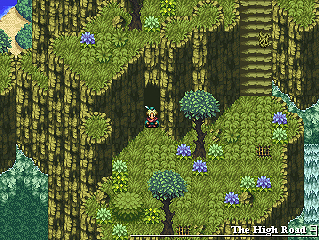
The mapping is solid, though this particular chipset
is a little overused. The area titles on the bottom-right
corner are a nice touch and are never overly distracting.
is a little overused. The area titles on the bottom-right
corner are a nice touch and are never overly distracting.
Nico’s edits of the classic Rudras charsets are very effective. None of the edits clash with the styles, and most fit the personalities of the characters. There are plenty of wonderful animations, battle graphics, overlays, and little objects to be found—all of which help to create a nice, somewhat dark atmosphere. I also enjoyed the monster graphics and found myself gazing at the details on many occasions.
Booble’s artwork adds a whole new dimension to the presentation. Her comic book-style scenes help make certain cutscenes memorable, and the facesets in particular are wonderful. These little augments can help to enhance other aspects of the game—or, rather, help players forgive errors in other aspects of the game. If a cutscene is a little long-winded but ends with a wonderful visual treat, then I’m usually satisfied. If a bloated cutscene ends with two charsets moving toward each other and away from each other at maximum speed to simulate fighting, then I’m less likely to be engaged. In other words, nice graphics can bolster a story that is otherwise bogged down by lackluster or long-winded writing.
My only minor complaint is that the quality of some of the visuals is diminished due to their being ported into 2k3. This is yet another reason to hate 2k3, but we can save that for the message boards. Additionally, I caught a few instances of RTP thrown into the battle animations—if Nico is going for a highly customized visual experience, then he should remove most (if not all) instances of RTP to avoid confusion. I also would have preferred something besides a black-and-white battle interface—the colored version looked so much better, if I recall correctly.
Graphic metrics:
Mapping: 4/5 (50%)
Other visuals: 4/5 (50%)
Overall: 4/5: "Great"

Forever’s End is on pace to become one of the best RPG Maker 2003 games, as long as its creator doesn't burn out. If Nico makes a few major adjustments—such as trimming the cutscenes, streamlining the inventory, and adding more strategy and depth to battles in future episodes—he could turn this game into an indie classic. I highly recommend this demo, but I suggest that players give it at least five hours before passing judgment. After all, the first couple of hours pale in comparison to the rest of the project.
Sadly, that last point is a problem all too common in our game design community. As newbies, we tend to think far too big; consequently, our first project is usually quite long and grandiose. By the time we're finished with the game, the beginning and end are of such vastly different quality levels that the game almost becomes unplayable. We are then forced to go back to the start and refine the first areas of the game to compensate. But then we realize that the entire game is fundamentally flawed due to poor gameplay and story decisions in the early planning stage, so we have to literally rework the entire game. I know this firsthand, and I'm sure Nico feels the same way. Fortunately, I believe Nico has avoided most of these pitfalls: only a few major changes will likely be needed to elevate this game to greatness.
Final metrics:
Story: 3/5 (25%)
Gameplay: 4/5 (30%)
Audio: 2.5/5 (20%)
Graphics: 4/5 (25%)
Overall: 3.5/5: "Good"
This review took forever to end. Sorry.

Posts 

I really like the format and style of this article. Combined with your writing it was a very enjoyable read.
Thanks, guys - glad you enjoyed it. There is just so much in this game; I'm sure there's plenty more to mention.
That inventory looks horrible. Also, YOU ARE A FEATHER.
I need to try this game a third time so I can provide a more exact critical analysis of the battle system. If you're going to have fighting, do it well or go home.
I need to try this game a third time so I can provide a more exact critical analysis of the battle system. If you're going to have fighting, do it well or go home.
author=Craze
That inventory looks horrible. Also, YOU ARE A FEATHER.
I need to try this game a third time so I can provide a more exact critical analysis of the battle system. If you're going to have fighting, do it well or go home.
There's a lot of junk in that trunk. Kinda like this review :D And the female leads in that cool beach pic :)
Calunio just pointed out a typo in my scoring metric/rubric/whatever. Setting is supposed to be 30 percent of the story score, not 25 percent. Herp derp.
First off, awesome job on the formatting of this review. It looks very professional and is extremely well written. Very nice. :)
I really agree with just about everything brought up in this review, and you make some good suggestions. However, out of all your points made, this one resonated with me the most:
This is basically it in a nutshell. I've said numerous times before how I never intended to really make Forever's End into a full game. It was more just an experiment to test out the 2k3 system, which I had never worked with before. When I finally decided to get serious about its creation, I was left with a rather newbish beginning. I revised the beginning a number of times, and although it still pales in comparison to later game material, it is considerably better than it was. Some people think I need to redo the beginning, but it isn't that simple anymore. If I redo the entire beginning, I would inevitably have to change the rest of the game as well. If I mess to much with the game's foundations, then the whole thing will just come crashing down. It's a tough situation. Honestly, I feel like radical changes to the start would be unproductive to completing the overall game. I'll just be consumed by an endless loop editing and replaying that will inevitably burn me out, just like it has so many other developers. This is RPG Making's biggest pitfall, and I'm not going to allow myself to fall in it. Eventually, we just need to say, "This is good enough" and move on with finishing the game. It may not be perfect, but nothing ever is.
Alright, that rant aside, a few other things to address. I never intended for my game to be a "tribute" to post-SNES/pre-PSX games. I know what you're saying about me labeling my game as such, but honestly, if you think a game about insane kings and magical crystals is completely original, then you need to play some more RPGs. I don't think anyone is going to download my game without at least glancing at the game's description. The general underlying theme is cliche, it's already set and done. Now all I can do is build off of it in a way that is enjoyable to the player and puts a new spin on these recognized ideas (which is what I'm trying to do).
I'm sorry about the cluttered inventory; this is another example of my initial newbishness to 2k3. I didn't really understand how the engine organized it's inventory, so I just threw stuff everywhere haphazardly. Problem is that now the only way to fix this would be to redo the whole inventory, which would in turn mean I would have to change every single map event, battle event, and common event where I used such-and-such item. It would probably take months to complete, and then even more months to fix all of the bugs. I'll probably do it eventually, but it's not something I'm looking forward to.
Music-wise, I've tried to change up the music from previous releases but I suppose there are still some recognizable tunes. I guess I've gotten so used to them that I have a hard time imagining scenes without them. I probably should just get rid of any FF music I have. I know some of you say I should go and download music from places like Newgrounds so that I have a "custom" soundtrack, but honestly, I've spent hours listening to their songs, and I found most of it to be shit. Trying to make a custom-indie soundtrack for my game that actually sounds good and consistent seems damn near impossible.
I've got a few more things to address, but it's late here and I'm mega tired. I'll just say for now that I appreciate the well-constructed, well-written review, Dec, and the time you put into writing it. I will do my best to address every one of your criticisms that doesn't end with me burning out, losing my sanity, and rage-canceling my game.
I really agree with just about everything brought up in this review, and you make some good suggestions. However, out of all your points made, this one resonated with me the most:
Sadly, that last point is a problem all too common in our game design community. As newbies, we tend to think far too big; consequently, our first project is usually quite long and grandiose. By the time we're finished with the game, the beginning and end are of such vastly different quality levels that the game almost becomes unplayable. We are then forced to go back to the start and refine the first areas of the game to compensate. But then we realize that the entire game is fundamentally flawed due to poor gameplay and story decisions in the early planning stage, so we have to literally rework the entire game.
This is basically it in a nutshell. I've said numerous times before how I never intended to really make Forever's End into a full game. It was more just an experiment to test out the 2k3 system, which I had never worked with before. When I finally decided to get serious about its creation, I was left with a rather newbish beginning. I revised the beginning a number of times, and although it still pales in comparison to later game material, it is considerably better than it was. Some people think I need to redo the beginning, but it isn't that simple anymore. If I redo the entire beginning, I would inevitably have to change the rest of the game as well. If I mess to much with the game's foundations, then the whole thing will just come crashing down. It's a tough situation. Honestly, I feel like radical changes to the start would be unproductive to completing the overall game. I'll just be consumed by an endless loop editing and replaying that will inevitably burn me out, just like it has so many other developers. This is RPG Making's biggest pitfall, and I'm not going to allow myself to fall in it. Eventually, we just need to say, "This is good enough" and move on with finishing the game. It may not be perfect, but nothing ever is.
Alright, that rant aside, a few other things to address. I never intended for my game to be a "tribute" to post-SNES/pre-PSX games. I know what you're saying about me labeling my game as such, but honestly, if you think a game about insane kings and magical crystals is completely original, then you need to play some more RPGs. I don't think anyone is going to download my game without at least glancing at the game's description. The general underlying theme is cliche, it's already set and done. Now all I can do is build off of it in a way that is enjoyable to the player and puts a new spin on these recognized ideas (which is what I'm trying to do).
I'm sorry about the cluttered inventory; this is another example of my initial newbishness to 2k3. I didn't really understand how the engine organized it's inventory, so I just threw stuff everywhere haphazardly. Problem is that now the only way to fix this would be to redo the whole inventory, which would in turn mean I would have to change every single map event, battle event, and common event where I used such-and-such item. It would probably take months to complete, and then even more months to fix all of the bugs. I'll probably do it eventually, but it's not something I'm looking forward to.
Music-wise, I've tried to change up the music from previous releases but I suppose there are still some recognizable tunes. I guess I've gotten so used to them that I have a hard time imagining scenes without them. I probably should just get rid of any FF music I have. I know some of you say I should go and download music from places like Newgrounds so that I have a "custom" soundtrack, but honestly, I've spent hours listening to their songs, and I found most of it to be shit. Trying to make a custom-indie soundtrack for my game that actually sounds good and consistent seems damn near impossible.
I've got a few more things to address, but it's late here and I'm mega tired. I'll just say for now that I appreciate the well-constructed, well-written review, Dec, and the time you put into writing it. I will do my best to address every one of your criticisms that doesn't end with me burning out, losing my sanity, and rage-canceling my game.
Yeah, a lot of my suggestions will be very hard to implement at this point (such as the inventory and intro changes). I tried to be as forgiving as possible because 2k3's inventory system is quite annoying. The cliches didn't really affect the score either, though I think some misdirection wouldn't hurt :)
For music, you can get lots of good RPG music(They're midi, which you might not want, but they're smaller files and personally I feel match the graphics better than MP3s) from here. At the very least, it'll help you make your soundtrack less recognizable. There are some MP3s there as well.
Corfaisus
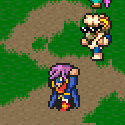

"It's frustrating because - as much as Corf is otherwise an irredeemable person - his 2k/3 mapping is on point." ~ psy_wombats
7874
I'm not sure if it's the cinematic intro that people have problems with, or if it's the king/shady subordinate/regretful captain speech section. But if it's the prior, I don't see what the big deal is. I personally felt it was magnificent, beautiful, if not a little heart-wrenching to see the fallen world and those who continue to walk the desecrated wastelands as ash rains from the heavens, ending with those supposedly responsible sharing a sort of high-five moment with their success.
author=Corfaisus
I'm not sure if it's the cinematic intro that people have problems with, or if it's the king/shady subordinate/regretful captain speech section. But if it's the prior, I don't see what the big deal is. I personally felt it was beautiful, if not a little heart-wrenching to see the fallen world and those who continue to walk the desecrated wastelands as ash rains from the heavens, ending with those supposedly responsible sharing a sort of high-five moment with their success.
For me it's more of the latter. The former is a solid intro proper, but I think it drags on a bit too long for my tastes. Not a big deal though.
Glad to see you people are still awake! I rather agree with Corfaisus but on a lager scale : I enjoyed the game like few others, and found it was really great on all levels! Of course it is not perfect, but no game is! (and maybe that's part of what makes them interesting), and i can understand that reviews are made to really go into things, but, as for the comments(AND some reviews!) there seems to be, with Forever's end, for i don't know what reason, an extreme, and i mean extreme, overfussing about all and every detail, and what's more endless! which I really don't understand ! Its the overall of the game that counts and it is not equal to the sum of its uncountable details, which for the most, i find extremely fun, original and picturesque like exactly the overall game!
chana
I rather agree with Corfaisus but on a lager scale
You played the game while drunk? Well, that explains a lot. #Ark
No I just find some of the negative criticism quite overdone this said i'm not a maker, so my view of a game is not the same, i'm aware of that, but even though...
(This said : what a thing to say, disagreement doesn't necessarily imply insult...... who's the "drunkest" here!)
oh i just read your comment on Sailerius' review (looking for an explanation...), keep cool man, this is a game!
fun, you know..!
(This said : what a thing to say, disagreement doesn't necessarily imply insult...... who's the "drunkest" here!)
oh i just read your comment on Sailerius' review (looking for an explanation...), keep cool man, this is a game!
fun, you know..!
Looks like I'll have to play through this new version. Corfasius, Nico and I had discussed some of these ideas during early demos, and I passed along some music- MP3s at the time, though i don't know if they're in use now. Oh and Corfasius, maybe you've gotten too used to knowing more than the characters. :P I'll check out the new version, see what I think.
















